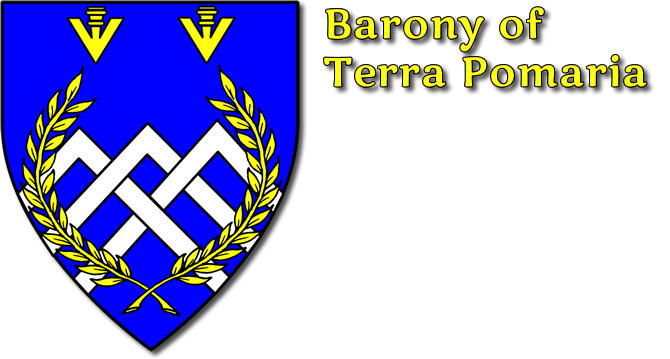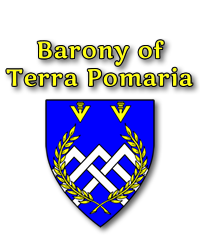19 Jun Chardequince
Then Serve It Forth…
By Lady Rosemary Willowwood de Ste. Anne
This month’s column will be several things – a recipe, a language lesson, and a recommendation for an outstanding source of information on medieval cookery. The source is a journal called Petits Propos Culinaires, which, despite its French title, is written in English, and is a superb source for modern research on medieval food.
Chardequince” (Quince Conserve)
From a Latin compilation in the library of Gonville and Caius College, University of Cambridge
Anonymous author, translated by Debby Banham & Laura Mason
Recipe Quinces et diuide in IIII partes cum cutello et capias pulpas diuisas a granulis et bullias eas in una patella cum aqua clara quousque sint valde molles tunc depone de igne et stringas per medium vnius streynour vel vnius cribri ana[sic, = anglice] sive et si sint de pulpa viii libras apponas vj libras mellis clarificati et ponas super ignem et permittas bullire continue mouendo cum vnam spadam quousque perfecte coquatur et hoc probes isto modo capias cultellum et capias de materia super punctum cultelli dt permitte infrigidare et que infrigidatur si materia in se fuerit aliqualiter fortis anglice styff tunc satis decoquitur tunc depone de igne et moueas bene quousque incipiat albescere tunc apponas pulueris yringorum libras duas zinziberi munitin [sic, = minutim] [ui]scili {uncias} iii pulueris zinziberi {uncial} vj et omnia ista incorporata ponas in pixidibus et vsui reserua in isto modo poteris facere Chardewardoun Chardecrabbe Chardedate sed dactili erunt triti in mortario et non cotti [sic] et mel erit coctum quousque hereat fortiter inter di[cc>g]itos et tunc imponas dactilos et si vis preparare cum zucur’ ponas ad vnam libran pulpe ij libras zucur’ clarificat[um] ij {uncias} pulueris vt superius dicitur excepto quod non impones puluerem yringorum.
TRANSLATION: Translation is by Debby Banham & Laura Mason, Petits Propos Culinaires 69, © 2002, Prospect Books, Devon, and the named authors. In the journal, this translation is presented as “dual language”, Latin on the left page and English on the right.
Take quinces and divide in 4 pieces with a knife and take the flesh separated from the pips and boil it in a pan with clear water until it is soft, then remove from the fire and strain through the middle of a strainer or sieve, in English sieve, and if there are eight pounds of flesh add 6 pounds clarified honey and put in over the fire and let it boil, stirring continuously with a ‘sword’ until it is completely cooked, and test this in this way: take a knife, and take some of the mixture on the point of the knife and let it cool and what cools, if the mixture is in itself somewhat strong, in English stiff, then it is cooked enough: then remove from the fire and stir well until it begins to turn white, then add two pounds of eringo powder, 3 ounces of ginger, very finely [chopped?] and 6 ounces of ginger powder, and put all these, combined, into boxes and keep until needed, and in this way you can make Chardewarden, Chardecrab, Chardedate, but the dates shall be ground in a mortar and not cooked, and the honey shall be cooked until it sticks hard between the fingers, and then put in the dates, and if you want to prepare it with sugar, put to one pound of pulp 2 pounds of clarified sugar, 2 ounces of spices, as stated above, except that you do not put in eringo powder.
REALIZATION: Several recipes for the price of one, here! A short explanation to clarify what we are cooking here. The “char” in “chardequince” means “flesh”, adapted from the Latin carne, or “flesh”. Therefore, “Chardewarden” means “flesh of Warden pears”, and “Chardecrabbe” would mean “flesh of crabapples”. You now have enough information to translate the rest of the dishes.
Cut whole peeled quinces in quarters, and core out the seeds (pips). Add enough water to cover the bottom of a heavy-bottomed saucepan in which you will cook the quinces; add the quinces, cover tightly, and cook over low-to medium heat until very soft. They will give up more juice than you think, just keep them from scorching until they soften. Strain the pulp through a fine sieve or jelly-bag, but don’t press the pulp; you are after the pulp here, not the juice. Combine the strained pulp with honey, ¾ cup honey for every cup of strained pulp. Bring to a slow boil, stirring constantly, and cook until VERY thick. You should be almost able to cut a trench through the mass with a spoon without it running back together. Remove from the heat, stirring to cool the mass, and as it cools, stir in 1 Tbsp. ground ginger and 1 Tbsp. grated fresh ginger per cup of pulp. I have never been able to find Eringo root in a store here, but if you have candied ginger or candied angelica stems, they may be finely chopped and stirred in to taste. Pour into lightly buttered pan and cool completely. When cool, you should be able to cut it into squares like fudge. They can be rolled in a mixture of cornstarch and powdered sugar and served as a sweet, ot, in medieval fashion, added to other foods as an ingredient.
The language lesson shows where our English word “recipe” comes from. Most medieval recipes start out with, “Take apples”, or “Take fair beef”, or in this case, “Take Quinces” … and do something with them. The imperative form of “take” in Latin is “Recipe”, so on a page, every set of instructions would begin with “Recipe”. If you read the Latin version of this piece, you will notice that the language seems to weave back and forth between Latin and English, with occasional lapses into translation. (For example, “Recipe Quinces” (Latin word, English word), and “vnius streynour vel vnius cribri ana [sic, = anglice] sive”’ “Streynour” and “sive” are interpolations of English words “strainer” and “sieve”). Provides interesting realms for speculation on who wrote this collection and why, and how did the quire get bound into a monastery collection in the first place!?!
GLOSSARY:
Eryngoes: Eryngium maritimum, or Sea Holly, is a plant much used in the middle ages as a confection, the roots and peeled stems of which were candied and eaten much like angelica.



